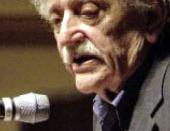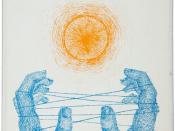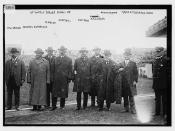A novel tells a story through a sequence of events. It entertains a reader with its power descriptions and dramatic plots. In addition, it's the perfect place for the author to voice his/her opinion or point of view. In the 20th century, American novelists question of the beliefs of its predecessor and issues of society. They, in their novels, question what they perceive as a world of lies.
In the Kurt Vonnegut's "Cat's Cradle," Jonah, the protagonist, aims to write a book accounting "what important Americans had done on the day when the first atomic bomb was dropped on Hiroshima." Through his journey, Jonah reveals the views and perceptions of the author. Vonnegut exposes the issue of religion. The string game, "cat's cradle," symbolizes the issue of religion. The cat's cradle, when closely examined, contains "no damn cradle. No damn cat." It's just a "bunch of X's between someone's hands."
Like the cat's cradle, when religion is closely examined, it's empty. He believes religion is made up of lies to keep people in order and prevent chaos. He tells the reader to "live by the foma (harmless untruths) that make you brave and kind and healthy and happy." Vonnegut also addresses the issue of science. Vonnegut argues how science enables the scientist to disassociate himself from the consequences and responsibilities. In "Cat's Cradle," Jonah travels to San Lorenzo where he's asked by Frank Hoenikker to be the new president. Jonah agrees and Frank promises to do the "technical work" and support him. Thus doing so, Frank is enabled to research without facing the public. He escapes his responsibilities. The interview between Jonah and Dr. Breed is another example. Dr. Breed recalls the history of the man that was hanged in Ilium in 1782. The man, described...


